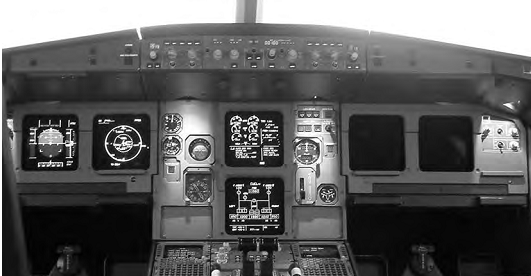
2.2.3.3. Electronic indicating systems
There are two formats of electronic indicating systems in widespread use on larger passenger aircraft: EICAS and ECAM. The Engine Indication and Crew Alerting System (EICAS) is a Boeing-developed system that provides all engine instrumentation and crew annunciations in an integrated format. The system used on Airbus aircraft is the Electronic Centralized Aircraft Monitoring (ECAM) system. The two systems operate on different philosophies; however, their basic functions are to monitor aircraft systems and display relevant information to the pilots. Both systems produce warnings, cautions and advisory messages that need to be evaluated by the crew. In certain cases, the system provides the procedures required to address the problem. Each colour display unit uses either an active matrix liquid crystal display (AMLCD) or a cathode ray tube (CRT).
EICAS is arranged with two displays in the centre instrument panel (upper and lower), see Fig.16 ECAM uses either a left and right display, see Fig.17, or an upper and lower arrangement. The information displayed by EICAS/ECAM includes engine thrust, engine r.p.m., fuel flow, oil temperature and pressure. Graphical depiction of aircraft systems can also be displayed; this includes electrical, hydraulic, de-icing, environmental and control surface positions.

Figure 16 EICAS
EICAS
System features include:
• primary engine parameters displayed on a fulltime basis
• secondary engine parameters displayed as required
• automatic monitoring of systems
• fault codes, fault history, self test (lower display)
• two computers (includes interfaces, symbol generator, memory)
• select panel, control switches, annunciation, standby display.
This integrated system improves reliability through elimination of traditional engine gauges and simplifies the flight deck through fewer stand-alone indicators. EICAS also reduces crew workload by employing a graphical presentation that can be rapidly assimilated. A typical EICAS comprises two large high-resolution colour displays together with associated control panels, two or three EICAS data concentrator units and a lamp driver unit. The primary EICAS display presents primary engine indication instruments and relevant crew alerts. It has a fixed format providing engine data including:
• engine thrust (EPR)
• engine rotational speed (N1)
• exhaust gas temperature (EGT).
If N1 or EGT limits are exceeded, their respective pointers and digital readouts change from white to yellow, and eventually to red. Exceedance information is stored in non-volatile memory (NVM) for access by maintenance engineers when troubleshooting the systems.
Messages are displayed as part of the Caution Alerting System (CAS); these are colour-coded to indicate their importance. Typical messages include low-pressure in the fuel or hydraulic oil systems, doors not closed etc. System warnings are automatically colour-coded and prioritized; they are accompanied by an audible warning depending on the message priority:
• Warning messages are red, accompanied by an audio alert (prompt action is required by the crew).
• Caution messages are yellow accompanied by an audio alert (timely action is required by the crew).
• Advisory messages are yellow, no audio alert (time available attention is required by the crew).
The secondary EICAS display indicates a wide variety of options to the crew and serves as a backup to the primary display. Pages are selectable using the EICAS control panel and includes many types of system information, for example:
• hydraulic systems pressure
• flying controls position
• cargo bay temperature
• brake temperatures
• tyre pressures.
The information on the aircraft system data buses is routed to both EICAS displays and both multifunction displays. A data concentrator unit (DCU) receives data in various formats from a variety of sensors, including the high- and low-speed ARINC 429 bus, from analogue and discrete inputs from the engines and other aircraft systems. In the event of a display system failure, the other system displays essential information in a compacted format. Primary engine indications are as before, secondary indications are digital readings only. In the event that both systems fail, a standby LED display is used for EPR, N1 and EGT.
ECAM
This is a flight-phase-related architecture; displays are automatically selected for:
• pre-flight
• take-off
• climb
• cruise
• descent
• approach.
To illustrate ECAM features, during the pre-flight phase, checklists are displayed on the left-hand screen; this includes information such as brake temperatures, APU status and advisory messages. During the pre-flight checks, the right-hand display provides a graphic representation of the aircraft, e.g. if doors are open or closed. The system automatically changes to the relevant pages needed for the next flight phase. System warnings are prioritized, ranging from level one to level three; the warning hierarchy is similar to EICAS.

Figure 17 ECAM
Both EICAS and ECAM reduce flight deck clutter by integrating the many electro-mechanical instruments that previously monitored engine and aircraft systems. Reliability is increased, and the pilot workload is reduced.
